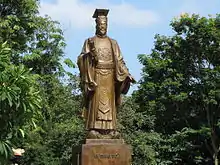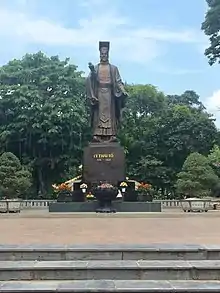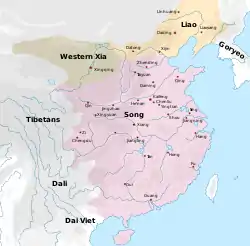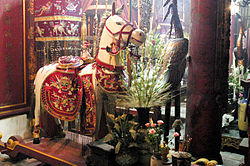Lý Thái Tổ
Lý Thái Tổ (Hán tự: 李太祖, 8 March 974 – 31 March 1028), personal name Lý Công Uẩn, temple name Thái Tổ, was a Vietnamese monarch, the founder of the Lý dynasty of Vietnam and the 6th ruler of Đại Việt; he reigned from 1009 to 1028.
| Lý Thái Tổ 李太祖 | |||||||||||||||||
|---|---|---|---|---|---|---|---|---|---|---|---|---|---|---|---|---|---|
| Emperor of Đại Cồ Việt | |||||||||||||||||
 Statue of Lý Thái Tổ beside the Hoàn Kiếm Lake in Hanoi | |||||||||||||||||
| Emperor of Đại Cồ Việt | |||||||||||||||||
| Reign | 1009–1028 | ||||||||||||||||
| Predecessor | Lê Long Đĩnh | ||||||||||||||||
| Successor | Lý Thái Tông | ||||||||||||||||
| Monarch of Lý Dynasty | |||||||||||||||||
| Reign | 20 November 1009–31 March 1028 | ||||||||||||||||
| Predecessor | Dynasty established | ||||||||||||||||
| Successor | Lý Thái Tông | ||||||||||||||||
| Born | 8 March, 974 Cổ Pháp, Bắc Giang, Đại Cồ Việt | ||||||||||||||||
| Died | 31 March, 1028 (aged 54) Thăng Long, Đại Cồ Việt | ||||||||||||||||
| Burial | Thọ Tomb | ||||||||||||||||
| Spouse | Lê Thị Phật Ngân and 8 other empresses | ||||||||||||||||
| Issue | Prince of Khai Thiên Lý Phật Mã as emperor Lý Thái Tông Prince of Khai Quốc Lý Bồ Prince of Đông Chinh Lý Lực Prince of Vũ Đức (? - 1028) Prince of Uy Minh Lý Nhật Quang Princess An Quốc 8 sons, and 13 daughters. | ||||||||||||||||
| |||||||||||||||||
| House | Lý | ||||||||||||||||
| Father | Hiển Khánh vương | ||||||||||||||||
| Mother | Minh Đức Thái hậu Phạm Thị | ||||||||||||||||
| Religion | Buddhism | ||||||||||||||||
| Temple name | |
| Vietnamese alphabet | Lý Thái Tổ |
|---|---|
| Hán-Nôm | 李太祖 |
| Personal name | |
| Vietnamese alphabet | Lý Công Uẩn |
|---|---|
| Hán-Nôm | 李公蘊 |
Early years
Lý Công Uẩn was born in Cổ Pháp village, Đình Bảng, Từ Sơn, Bắc Ninh Province in March 974. Lý Công Uẩn’s family background is mysterious. According to the Vietnamese chronicle, he was conceived when his mother had intercourse with a "divine being" at a temple in the heartland of northern Vietnam and at the age of 3 was given for adoption to a man named Lý Khánh Vân, of whom not much information is available. Some historical sources claim that Lý Công Uẩn's paternal line originated from Fujian, China.[1][2][3][4][5] This view, however, is challenged by some modern historians.[6] He was educated by Vạn Hạnh, the most eminent Buddhist patriarch of the time, in the village of Đình Bản, a short distance across the Red River from Hanoi to the northeast. He acquired a reputation as a devout Buddhist, and then a historian student, and a soldier.[7] He was gradually promoted from a minor official to a prominent post of the government and was ultimately bestowed with the title Tả Thân Vệ Điện Tiền Chỉ Huy Sứ (The Commander of the Palace's Left Flank), which was one of the most important positions within the royal guards.
In 1005, the ruling king Lê Hoàn died, resulting in a civil war between his sons.[8] As Lê Hoàn’s sons were being entitled and their entourages were being assembled, Lý Công Uẩn began serving at the royal court, eventually rising to a high position of trust at the side of the designated heir to the throne. It is not clear whether the Lý family was a prominent clan in its own right or a clan of convenience for the monks into which were adopted the most promising students from the temples. Vạn Hạnh, just prior to Lý Công Uẩn taking the throne, reportedly asserted that, considering all the families in the realm, the Lý family was "exceedingly large", and the expression recorded could even be read as meaning "the largest."[6] In 1009, the ruling king Lê Long Đĩnh (r. 1005–1009), the last king of the Lê family, developed hemorrhoids and had to lie down while listening to officials’ reports.[9] Incapacitated by declining health, Long Đĩnh watched helplessly as the monks of Giao launched a propaganda campaign that nurtured belief in the inevitability of Lý Công Uẩn becoming king.[6] He died in November 1009 and aged twenty-five died under the wrath of the people because of his brutality and cruelty he brought onto them during his reign. Đào Cam Mộc, an royal official, and Vạn Hạnh seized the opportunity and imposed their power and political influence to enthrone their trusted disciple Lý Công Uẩn without much resistance, thus ended the reign of the Lê dynasty.[9]
Two days after Long Đĩnh's death,advised and assisted by his patron, the monk Vạn Hạnh, and by the efforts of the entire Buddhist establishment, Lý Công Uẩn was proclaimed king by general acclamation.[7] After his ascension to the throne, Lý Công Uẩn named his era "Thuận Thiên" (順天) meaning "Will of Heaven".
Reign
Capital relocation

The royal court decided to relocate from Hoa Lư to the site of Đại La (modern-day Hanoi) in the next year, 1010.[10] Đại La was known as the city that the Tang general Gao Pian had built in the 860s after the ravages of the Nanzhao War. In 1010, Lý Công Uẩn published an edict explaining why he was moving his capital to this place. Citing kings who moved their capitals during the Shang and Zhou dynasties in classical antiquity, the edict compared Hoa Lư unfavorably to "King Gao’s old capital at Đại La", which was centrally located amidst the abundance of a broad plain and which displayed the marks of geomantic potency. Đại La was only ten kilometers from Đình Bảng, where Lý Công Uẩn had been raised and educated by Vạn Hạnh.[6] Lý Công Uẩn chose the site because it had been an earlier capital in the Red River Delta amidst land rich for wet rice agriculture. Lý Công Uẩn saw Đại La as a place "between Heaven and Earth where the coiling dragon and the crouching tiger lie, and his capital would last 10,000 years".[11] When Lý Công Uẩn’s boat docked at the new capital, a dragon, symbol of sovereign authority, reportedly soared above his head; he accordingly renamed the place Thăng Long, the "ascending dragon".[12]
The royal city at Thăng Long was laid out in the standard pattern: the urban center encompassed the Royal City, which contained the Forbidden City within its walls. The Throne Room Palace was located within a Dragon Courtyard and faced south. The Crown Prince of the Lý dynasty resided in the Eastern Palace outside the city walls.[11] Palaces and offices were constructed of timber, which explains why little of them remain. Càn Nguyên Palace where the king held audience was located on Mount Nùng. Two other palaces were constructed, one on either side of this palace, and two other palaces behind it, Long An and Long Thụy Palaces, residences of the king. By 1010, 11 palaces were located in Thăng Long.[11] The earthworks which were ramparts of his new capital still stand to the west of the modern city of Hanoi, forming a vast quadrilateral by the side of the road to Sơn Tây. A number of objects have been discovered at this site, which were either turned up during the process of tilling the soil, or were found by means of clandestine diggings.[13] They included terracotta tiles, fragments of cloth, pieces of turned-up corners of ridge tiles, and ceramics, many of which are celadon ware.
Domestic policies

The outer regions of the Red River Delta, beyond the Lý heartland, were in the hands of families allied with the Lý family by marriage. Lý Thái Tổ abandoned a scheme of dividing the plain into "ten circuits" that had been devised by Đinh Bộ Lĩnh (r. 968–979) and replaced it with 24 routes; these were not administrative jurisdictions but rather itineraries designating various localities. He organized the southern provinces into military outposts, indicating a policy of garrisons and patrols.[14] Officials did not receive a salary controlled by the capital, but were entirely dependent upon local resources, a region's fish and rice. The soldiers did receive some largesse at the same time as they were expected to do some farming of their own.[15] The village communities scattered about the countryside stayed within their own frames of reference except in times of emergency or of specific royal demands. Only then would they interact with the central power. Otherwise they sent some of their resources to the local lord, who in turn forwarded a share as tribute to the throne.[16] This administrative system resembles a naturally Southeast Asian mandala system.[17]
In 1011, Lý Thái Tổ raised a large army and attacked rebels in the southern provinces, in what is now Thanh Hoá and Nghệ An. He campaigned there for two years, burning villages and capturing local leaders. While returning by sea in late 1012, a great storm threatened to sink his boat, which he understood as a divine judgment upon him for the violence he had brought upon so many people.[18] A speech was recorded that he reportedly made amidst the storm, addressed to the heavenly power, in which he acknowledged that the innocent might have been harmed in error but that he nevertheless could not refrain from attacking these people because of their wickedness, cruelty, and savage resistance to "civilizing instructions"; he begged forgiveness for his soldiers and expressed his personal acceptance of any required punishment. In response to his appeal, according to the story, the storm abated and the sea became calm.[18]
For three years, 1013–1015, Lý Thái Tổ sent soldiers into the northern mountains, primarily the upland valleys of modern Hà Giang Province, to chastise people there who were falling under the influence of the Dali Kingdom in Yunnan. Soldiers commanded by a brother reportedly killed or captured thousands of people and obtained many horses.[18]
He also reformed the tax system in 1013 by creating six tax classifications, which enabled the royal court to efficiently collect taxes and citizens to clearly know which tax classification affected them, for instance, applied mostly to goods produced on royal estates:[19]
- Tax on fishing and seafood production
- Tax on agricultural production (farming)
- Tax on logging/wood and masonry
- Tax on salt production
- Tax on luxury goods production (ivory, gold, silk, precious materials, etc.)
- Tax on fruits and vegetable production
When a severe earthquake occurred in 1016, Lý Thái Tổ prayed to the gods that were in charge of the mountains surrounding the capital, while also sending more than 1,000 people to teach in Buddhist schools. He journeyed around his kingdom both to propitiate its disparate genies and co-opt them by having them "declare" themselves to him.[20][21]
Foreign affairs

During the reign of Lý Thái Tổ, the Song Dynasty was pre-occupied with maintaining internal stability and still recovering from previous defeats or skirmishes with the Liao dynasty and Western Xia. Đại Việt, as a result, was mostly left alone and political relations between the two states revived. During the disorders following Lê Hoàn’s death, Song border officials had argued in favor of military intervention, but the emperor refused to act and admonished officials to avoid becoming embroiled in the violent affairs of distant uncivilized people. In 1010, Song recognized Lý Công Uẩn without delay, conferring upon him the usual titles of vassalage. Thereafter, Song maintained a pacifist policy, doing the minimum necessary to preserve border security, even willing to suffer minor violations. The aim of Song policy was to preclude any provocation that might arouse a major crisis requiring mobilization of armies into thesouth that were more urgently needed on the northern frontier.[12]
In 1010, Lý Thái Tổ attacked and caught thirteen persons of Địch Lão (bandit) ethnicity and presented the captives to the Chinese court. In 1014, Lý Thái Tổ made another gesture of reassurance to the Song court.[22] After subduing a Hani community, he turned the entire herd over to Song authorities, to mark that Đại Việt's commitment to the region’s standing political and trade arrangements. Horses were an extremely valuable trade item, bought at considerable expense for military purposes from traders residing in the neighboring Dali kingdom.[23]
Religious activities
Having begun life as a Buddhist monk, Lý Thái Tổ practiced Buddhism and promoted it as the national religion. As a result, he gave much support to the Buddhist clergy and institutions. He donated money to build pagodas throughout Đại Việt. Many citizens joined monastic institutions during this reign since he was a strong patron of the Buddhist religion. Initial, he built 8 Buddhist temples in the Tiên Du area, heart land of Vietnamese Buddhism and three others around the capital region itself.[24]
Consistent with his geo-administrative vision and his kingship to appease and tame the spirit world, during the eleventh century the Lý court "brought back" to Thăng Long a firmament of local spirits that had long dominated more distant regions of the kingdom. The spirits of the Trưng sisters from the western delta, the earth genie of Phù Đổng north of the capital, and the Mountain of Bronze Drum god from Thanh Hoá in Ái to the south were all relocated to the capital and housed there in temples specially dedicated to them. If these spirits were "symbols of regional powers", their pacification involved the extension of monarchical authority to the regions of Đại Việt.[20][25]
In 1024, a temple was built for Lý Thái Tổ to use for reading and reciting the Buddhist scriptures, a copy of which he had requested and received from the Song court a few years earlier. After establishing suitable relationships with the terrestrial powers, he showed an interest in establishing proper relationships with the supernatural powers, patronizing the Buddhist religion and local cults, thereby cultivating a cultural basis for his authority.[7] Thereafter he began to withdraw from public affairs. In 1025, Vạn Hạnh died. He had been Lý Thái Tổ’s teacher, mentor, and, to some extent, father figure. He had previously been an advisor to Lê Hoàn and was a central figure in effecting the transition from the Lê family at Hoa Lư to the Lý family at Thăng Long. It seems that Lý Thái Tổ’s royal personality was in some degree animated as an extension of Vạn Hạnh’s expectations of him, for from this time little of note is recorded about Lý Thái Tổ until his death in the spring of 1028.[26]
Death

Lý Công Uẩn died in 1028 at the age of 55 according to the royal official accounts. He was buried at Thọ Lăng, the Mausoleum of Longevity, outside of Thiên Đức Palace. He was posthumously named as "Lý Thái Tổ"; his posthumous imperial title was "Thần Võ Hoàng Đế". Today the ancestor spirit of Lý Thái Tổ is among those popularly honoured in rites at national shrines.[27]
Family
- Father
- Hiển Khánh vương (posthumously honored by Lý Thái Tổ in 1010)
- Lý Khánh Vân (adoptive father)
- Mother
- Phạm Thị Ngà
- Brothers
- Dực Thánh Vương (翊聖王)
- Lý Mỗ
- Wives
- Empress Lập Giáo
- Lady Chu Ái Vân (婤爱雲夫人)
- Children
- Lý Phật Mã (李佛瑪)
- Lý Long Bồ (李龍菩) (?–1069)
- Lý Lực
- Lý Cập
- Lý Phó
- Lý Nhật Quang (李日㫕) (995–1057)
- Princess An Quốc
- Princess Lĩnh Nam (Lý Thị Bảo Hòa)
Ancestry
| Ancestry of King Lý Thái Tổ | |||||||||||||||||||||||||||||||||||||||||||||||||
|---|---|---|---|---|---|---|---|---|---|---|---|---|---|---|---|---|---|---|---|---|---|---|---|---|---|---|---|---|---|---|---|---|---|---|---|---|---|---|---|---|---|---|---|---|---|---|---|---|---|
| |||||||||||||||||||||||||||||||||||||||||||||||||
References
Citations
- Le Minh Khai (Liam Kelley Professor of Vietnam History at University of Hawaii at Manoa). The Stranger Kings of the Lý and Trần Dynasties. Archived from the original on 2016-03-11. Retrieved 2019-10-21.
-
Dream Pool Essays volume 25 Classical Chinese :桓死、安南大亂、久無酋長。其後國人共立閩人李公蘊為主。 — 夢溪筆談 卷25
 Chinese Wikisource has original text related to this article: 夢溪筆談/卷25
Chinese Wikisource has original text related to this article: 夢溪筆談/卷25 - (in Chinese) 千年前泉州人李公蕴越南当皇帝 越南史上重要人物之一
- (in Chinese) 两安海人曾是安南皇帝 有关专家考证李公蕴、陈日煚籍属晋江安海
- Lynn Pan (1998). The Encyclopedia of the Chinese Overseas. Harvard University Press. p. 228. ISBN 0674252101.
- Taylor 2013, p. 60.
- Tarling 1999, p. 140.
- Anderson 2011, p. 97.
- Kiernan 2019, p. 147.
- Pelley 2002, p. 213.
- Miksic & Yian 2016, p. 433.
- Taylor 2013, p. 61.
- Coedès 2015, p. 83.
- Taylor 2013, p. 62.
- Whitmore 1986, p. 129.
- Whitmore 1986, p. 127.
- Whitmore 1986, p. 128.
- Taylor 2013, p. 63.
- Kiernan 2019, p. 150.
- Kiernan 2019, p. 151.
- Kiernan 2019, p. 153.
- Anderson 2011, p. 98.
- Anderson 2011, p. 99.
- Whitmore 2015, p. 287.
- Kiernan 2019, p. 152.
- Taylor 2013, p. 64.
- Fjedstad & Nguyen 2011, p. 18.
Bibliography
- Taylor, K.W. (2013), A History of the Vietnamese, Cambridge University Press, ISBN 978-0-520-07417-0
- Kiernan, Ben (2019). Việt Nam: a history from earliest time to the present. Oxford University Press. ISBN 978-0190053796.
- Whitmore, John K. (1986), ""Elephants Can Actually Swim": Contemporary Chinese Views of Late Ly Dai Viet", in Milner, Anthony Crothers; Marr, David G. (eds.), Southeast Asia in the 9th to 14th Centuries, Cambridge: Institute of Southeast Asian Studies, pp. 117–137, ISBN 978-9-971-98839-5
- Tarling, Nicholas (1999). The Cambridge History of Southeast Asia: Volume 1, From Early Times to c.1800. Cambridge University Press. ISBN 978-0-521-66372-4.
- Miksic, John Norman; Yian, Go Geok (2016). Ancient Southeast Asia. Taylor & Francis. ISBN 1-317-27903-4.
- Whitmore, John K. (2015), "Building a Buddhist monarchy in Dai Viet: Temples and texts uder Ly Nhan Tong (1072-1127)", in Lammerts, Dietrich Christian (ed.), Buddhist Dynamics in Premodern and Early Modern Southeast Asia, ISEAS Publishing, Institute of Southeast Asian Studies, pp. 283–306, ISBN 978-9-814-51906-9
- Coedès, George (2015), The Making of South East Asia (RLE Modern East and South East Asia), Taylor & Francis, ISBN 9781317450955
- Anderson, James A. (2011), ""Slipping through hole": The Late Tenth- and Early Eleventh-Century Sino-Vietnamese Coastal Frontier as a Subaltern Trade Network", in Li, Tana; Anderson, James A. (eds.), The Tongking Gulf Through History, Pennsylvania: University of Pennsylvania Press, pp. 87–100, ISBN 978-0-812-20502-2
- Pelley, Patricia M. (2002). Postcolonial Vietnam: New Histories of the National Past. Duke University Press. ISBN 978-0-822-32966-4.
- Fjelstad, Karen; Nguyen, Thi Hien (2012). Spirits Without Borders: Vietnamese Spirit Mediums in a Transnational Age. Palgrave Macmillan. ISBN 113-7-29918-5.
Lý Thái Tổ Born: 974 Died: 1028 | ||
| Regnal titles | ||
|---|---|---|
| Preceded by Lê Long Đĩnh |
Emperor of Đại Cồ Việt 1009–1028 |
Succeeded by Lý Thái Tông |
| New title | Emperor of Lý Dynasty 1009–1028 | |
| Lý royal family (notable members) | |||||||||||||||||||||||||||||||||||||||||||||||||||||||||||||||||||||||||||||||||||||||||||||||||||||||||||||||||||||||||||||||||||||||||||||||||||||||||||||||||||||||||||||||||||||||||||||||||||||||||||||||||||||||||||||||||||||||||||||||||||||||||||||||||||||||||||||||||||||||||||||||||||||||||||||||||||||||||||||||||||||||||||||||||||||||||||||||||||||||||||||||||||||||||||||||||||||||||||||||||||||||||||||||||||||||||||||||||||||||||||||||||||||||||||||||||||||||||||||||||||||||||||||||||||||||||||||||||||||||||||||||||||||||||||||||||||||||||||||||||||||||||||||||||||||||||||||||||||||||||||||||||||||||||||||||||||||||||||||||||||||||||||||||||||||||||||||||||||||||||||||||||||||||||||||||||||||||||||||||||||||||||||||||||||||||||||||||||||||||||||||||||||||||||||||||||||||||||||||||||||||||||||||||||||||||||||||||||||||||||||||||||||||||||||||||||||||||||||||||||||||||||||||||||||||||||||||||||||||||||||||||||||||||||||||||||||||||||||||||||||||||||||||||||||||||||||||||||||||||
|---|---|---|---|---|---|---|---|---|---|---|---|---|---|---|---|---|---|---|---|---|---|---|---|---|---|---|---|---|---|---|---|---|---|---|---|---|---|---|---|---|---|---|---|---|---|---|---|---|---|---|---|---|---|---|---|---|---|---|---|---|---|---|---|---|---|---|---|---|---|---|---|---|---|---|---|---|---|---|---|---|---|---|---|---|---|---|---|---|---|---|---|---|---|---|---|---|---|---|---|---|---|---|---|---|---|---|---|---|---|---|---|---|---|---|---|---|---|---|---|---|---|---|---|---|---|---|---|---|---|---|---|---|---|---|---|---|---|---|---|---|---|---|---|---|---|---|---|---|---|---|---|---|---|---|---|---|---|---|---|---|---|---|---|---|---|---|---|---|---|---|---|---|---|---|---|---|---|---|---|---|---|---|---|---|---|---|---|---|---|---|---|---|---|---|---|---|---|---|---|---|---|---|---|---|---|---|---|---|---|---|---|---|---|---|---|---|---|---|---|---|---|---|---|---|---|---|---|---|---|---|---|---|---|---|---|---|---|---|---|---|---|---|---|---|---|---|---|---|---|---|---|---|---|---|---|---|---|---|---|---|---|---|---|---|---|---|---|---|---|---|---|---|---|---|---|---|---|---|---|---|---|---|---|---|---|---|---|---|---|---|---|---|---|---|---|---|---|---|---|---|---|---|---|---|---|---|---|---|---|---|---|---|---|---|---|---|---|---|---|---|---|---|---|---|---|---|---|---|---|---|---|---|---|---|---|---|---|---|---|---|---|---|---|---|---|---|---|---|---|---|---|---|---|---|---|---|---|---|---|---|---|---|---|---|---|---|---|---|---|---|---|---|---|---|---|---|---|---|---|---|---|---|---|---|---|---|---|---|---|---|---|---|---|---|---|---|---|---|---|---|---|---|---|---|---|---|---|---|---|---|---|---|---|---|---|---|---|---|---|---|---|---|---|---|---|---|---|---|---|---|---|---|---|---|---|---|---|---|---|---|---|---|---|---|---|---|---|---|---|---|---|---|---|---|---|---|---|---|---|---|---|---|---|---|---|---|---|---|---|---|---|---|---|---|---|---|---|---|---|---|---|---|---|---|---|---|---|---|---|---|---|---|---|---|---|---|---|---|---|---|---|---|---|---|---|---|---|---|---|---|---|---|---|---|---|---|---|---|---|---|---|---|---|---|---|---|---|---|---|---|---|---|---|---|---|---|---|---|---|---|---|---|---|---|---|---|---|---|---|---|---|---|---|---|---|---|---|---|---|---|---|---|---|---|---|---|---|---|---|---|---|---|---|---|---|---|---|---|---|---|---|---|---|---|---|---|---|---|---|---|---|---|---|---|---|---|---|---|---|---|---|---|---|---|---|---|---|---|---|---|---|---|---|---|---|---|---|---|---|---|---|---|---|---|---|---|---|---|---|---|---|---|---|---|---|---|---|---|---|---|---|---|---|---|---|---|---|---|---|---|---|---|---|---|---|---|---|---|---|---|---|---|---|---|---|---|---|---|---|---|---|---|---|---|---|---|---|---|---|---|---|---|---|---|---|---|---|---|---|---|---|---|---|---|---|---|---|---|---|---|---|---|---|---|---|---|---|---|---|---|---|---|---|---|---|---|---|---|---|---|---|---|---|---|---|---|---|---|---|---|---|---|---|---|---|---|---|---|---|---|---|---|---|---|---|---|---|---|---|---|---|---|---|---|---|---|---|---|---|---|---|---|---|---|---|---|---|---|---|---|---|---|---|---|---|---|---|---|---|---|---|---|---|---|---|---|---|---|---|---|---|---|---|---|---|---|---|---|---|---|---|---|---|---|---|---|---|---|---|---|---|---|---|---|---|---|---|---|---|---|---|---|---|---|---|---|---|---|---|---|---|---|---|---|---|---|---|---|---|---|---|---|---|---|---|---|---|---|---|---|---|---|---|---|---|---|---|---|---|---|---|---|---|---|---|---|---|---|---|---|---|---|---|---|---|---|---|---|---|---|---|---|---|---|---|---|---|---|---|---|---|---|---|---|---|---|---|---|---|---|---|---|---|---|---|---|---|---|---|---|---|---|---|---|---|---|---|---|---|---|---|---|---|---|---|---|---|---|---|---|---|---|---|---|---|---|---|---|---|---|---|---|---|---|---|---|---|---|---|---|---|---|---|---|---|---|---|---|---|---|---|---|---|---|---|---|---|---|---|---|---|---|---|---|---|---|---|---|---|---|---|---|---|---|---|---|---|---|---|---|---|---|---|---|---|---|---|---|---|
| |||||||||||||||||||||||||||||||||||||||||||||||||||||||||||||||||||||||||||||||||||||||||||||||||||||||||||||||||||||||||||||||||||||||||||||||||||||||||||||||||||||||||||||||||||||||||||||||||||||||||||||||||||||||||||||||||||||||||||||||||||||||||||||||||||||||||||||||||||||||||||||||||||||||||||||||||||||||||||||||||||||||||||||||||||||||||||||||||||||||||||||||||||||||||||||||||||||||||||||||||||||||||||||||||||||||||||||||||||||||||||||||||||||||||||||||||||||||||||||||||||||||||||||||||||||||||||||||||||||||||||||||||||||||||||||||||||||||||||||||||||||||||||||||||||||||||||||||||||||||||||||||||||||||||||||||||||||||||||||||||||||||||||||||||||||||||||||||||||||||||||||||||||||||||||||||||||||||||||||||||||||||||||||||||||||||||||||||||||||||||||||||||||||||||||||||||||||||||||||||||||||||||||||||||||||||||||||||||||||||||||||||||||||||||||||||||||||||||||||||||||||||||||||||||||||||||||||||||||||||||||||||||||||||||||||||||||||||||||||||||||||||||||||||||||||||||||||||||||||||
Notes:
| |||||||||||||||||||||||||||||||||||||||||||||||||||||||||||||||||||||||||||||||||||||||||||||||||||||||||||||||||||||||||||||||||||||||||||||||||||||||||||||||||||||||||||||||||||||||||||||||||||||||||||||||||||||||||||||||||||||||||||||||||||||||||||||||||||||||||||||||||||||||||||||||||||||||||||||||||||||||||||||||||||||||||||||||||||||||||||||||||||||||||||||||||||||||||||||||||||||||||||||||||||||||||||||||||||||||||||||||||||||||||||||||||||||||||||||||||||||||||||||||||||||||||||||||||||||||||||||||||||||||||||||||||||||||||||||||||||||||||||||||||||||||||||||||||||||||||||||||||||||||||||||||||||||||||||||||||||||||||||||||||||||||||||||||||||||||||||||||||||||||||||||||||||||||||||||||||||||||||||||||||||||||||||||||||||||||||||||||||||||||||||||||||||||||||||||||||||||||||||||||||||||||||||||||||||||||||||||||||||||||||||||||||||||||||||||||||||||||||||||||||||||||||||||||||||||||||||||||||||||||||||||||||||||||||||||||||||||||||||||||||||||||||||||||||||||||||||||||||||||||